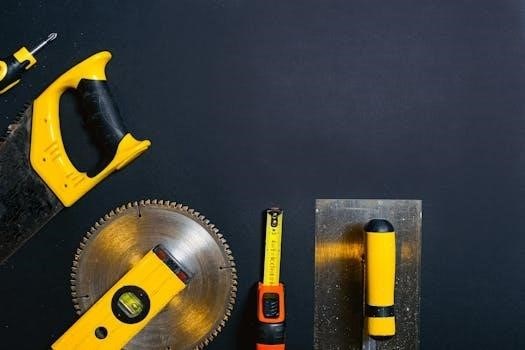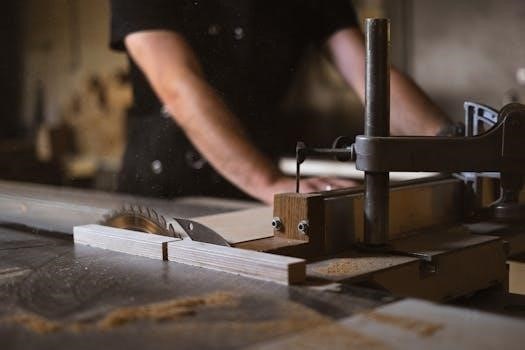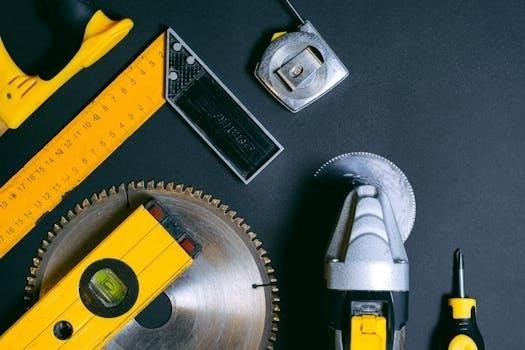Saw Blade Tooth Geometry⁚ An Overview
Saw blade tooth geometry is crucial for cutting performance. It includes tooth shape, arrangement, and angles, all influencing the cut quality and efficiency. Various tooth designs exist, including ATB, TCG, and others, each suited for specific materials and tasks. Understanding these geometries allows for optimal blade selection and usage, ensuring clean cuts.
Basic Tooth Shapes
Several fundamental tooth shapes are commonly found in saw blades, each designed for specific cutting applications. The most basic is the flat-top tooth, which is often used for ripping and general-purpose cutting, especially on softer materials. It offers a straightforward, efficient cut without the added complexity of beveled edges, making it a robust choice. Another common shape is the alternate top bevel (ATB) tooth, featuring alternating bevels on the top edges. This allows for cleaner cuts, particularly when crosscutting, and reduces splintering. The ATB design is prevalent in many general-purpose blades, providing a balance between cutting speed and finish quality. There are also variations like the hollow tooth, which is designed for specific materials and cutting styles, such as laminate or melamine. These shapes often include a unique curvature or bevel to reduce chipping. Furthermore, trapezoidal teeth are used for particularly hard materials, like certain plastics, and they are often paired with a flat-top tooth as part of a more complex cutting arrangement. Each of these basic shapes contributes to the overall performance of the saw blade, making the right choice vital for successful cutting tasks.

Alternate Top Bevel (ATB) Teeth
Alternate Top Bevel, or ATB, teeth are a popular design in saw blades, especially for woodworking. The defining characteristic of ATB teeth is their alternating bevels, where the top edge of each tooth is beveled to either the left or right. This alternating pattern creates a shearing action as the blade cuts through the material, producing a cleaner, smoother cut with less splintering. ATB blades are especially effective when crosscutting, where the cutting action occurs perpendicular to the wood grain. They are also commonly used in general-purpose blades, providing a good balance between cutting speed and finish quality. The angle of the bevels can vary, with steeper angles leading to more aggressive cuts, while shallower angles yield finer finishes. Often, ATB blades have a higher tooth count to further enhance the finish. This design is versatile, making it suitable for a wide range of materials from softwoods to hardwoods. The ATB tooth geometry helps to minimize the tear-out that can occur when cutting across the grain, a common issue with simpler tooth designs. The success of ATB teeth is rooted in their ability to produce clean cuts with less effort.
Triple Chip Grind (TCG) Teeth
Triple Chip Grind, or TCG, teeth feature a unique configuration designed for specific cutting applications. Unlike the alternating bevel of ATB teeth, TCG teeth have a more complex pattern, combining a trapezoidal tooth with a flat raker tooth. The trapezoidal tooth, also known as a chamfer tooth, leads the cut, followed by the flat raker tooth, which removes the remaining material and cleans the cut. This sequence is repeated around the entire blade. The trapezoidal tooth is designed to be the first point of contact, reducing the load on the following flat raker. TCG blades are favored for cutting dense materials like laminates, plastics, and non-ferrous metals due to their balanced cutting action and reduced vibration. The combination of the trapezoidal and flat tooth provides a smoother cut with less chance of chipping or tearing. TCG teeth also tend to have a longer lifespan because the cutting load is distributed between the two tooth types. While TCG blades may not be ideal for all woodworking applications, their robustness and clean cutting ability make them essential for specific materials. The unique tooth geometry of TCG blades allows for precise and efficient cutting in demanding environments. The design of TCG teeth is optimized for durability and cutting performance on challenging surfaces.

Key Elements of Saw Tooth Geometry
Key elements include tooth pitch (TPI), rake angle, fleam angle, and tooth set. These factors significantly affect cutting speed, finish quality, and the blade’s performance. Understanding these elements is essential for choosing the right blade and optimizing cutting results for different materials.
Tooth Pitch (TPI)
Tooth pitch, often measured in teeth per inch (TPI), describes the density of teeth on a saw blade. This element significantly influences a saw’s cutting characteristics. A higher TPI indicates more teeth packed into an inch, resulting in a finer cut with less material removal per tooth. This configuration is generally preferred for smoother finishes and slower cutting speeds, suitable for harder materials or precise work where a cleaner edge is desired. Conversely, a lower TPI means fewer teeth per inch, leading to more aggressive cuts with larger gullets between teeth. These larger gullets are essential for efficiently removing sawdust, making lower TPI blades better suited for softer, thicker materials where faster cutting is prioritized over the smoothness of the cut. The selection of appropriate TPI directly impacts both the quality and speed of the cut. A blade with too high a TPI may clog in softer materials, while a blade with too low a TPI can cause excessive tearing in harder materials. Understanding the relationship between TPI and the material being cut is thus fundamental to achieving optimal performance with any saw blade, ensuring both efficiency and quality in the finished product. Furthermore, tooth pitch is a crucial element to consider when matching a saw to its intended use. Choosing the correct TPI for the job helps avoid common problems such as binding, excessive vibration, and poor cut quality, thus enhancing both safety and the overall efficiency of the woodworking process.

Rake Angle
The rake angle, a critical aspect of saw tooth geometry, defines the aggressiveness of the cut. It’s the angle of the tooth’s cutting face relative to a line perpendicular to the saw blade. A zero-degree rake angle, where the tooth is vertical, results in a very aggressive cut. Introducing a positive rake, by leaning the tooth forward, increases aggression further, but it can make the saw harder to start and push, while also weakening the tooth. This is commonly seen in Japanese saws, where pulling action and harder steel mitigate these effects. Conversely, a negative rake angle, where the tooth leans backward, makes the saw easier to start and push, but slows down the cut, as the teeth tend to lift away from the cut. A reduced rake angle cuts faster but may feel more grabby and require more experience to handle. Adjusting this angle is essential for adapting to different wood hardnesses. A lower rake is good for fast cuts, but may need more skill to control, while a higher rake provides a smoother and easier start. The rake angle influences how effectively the blade engages with the material, making it a key element in achieving the desired cutting characteristics for the specific wood being worked. Understanding the relationship between the rake angle and the material is thus essential for optimizing saw performance, ensuring both efficiency and desired finish quality.
Fleam Angle
The fleam angle, another crucial element in saw tooth geometry, is the angle across the face of the tooth, perpendicular to the tooth line. Adding fleam transforms saw teeth into small knives that slice through the wood grain instead of chopping it. The more fleam you add, the cleaner the cut, but it also weakens the teeth, making them more brittle. High fleam angles result in smaller tooth fronts, making them more fragile, which is why high-fleam saws are best for softer woods, where there is less force on the teeth. Conversely, saw teeth with little to no fleam will produce a rougher cut and require more effort to move through the wood. The slicing action from fleam is essential for a crosscut saw to perform well without splintering or tearing across the grain. Fleam enables a clean cut because it allows the teeth to sever the wood fibers rather than tear them away. The angle of fleam is a trade-off⁚ more gives a cleaner cut at the expense of tooth strength, while less provides a stronger tooth with a rougher cut. Thus, the choice of fleam angle depends on the wood type and the desired finish quality. The proper fleam angle is essential for achieving a smooth, efficient cut, making it a key factor in saw performance.
Tooth Set
Tooth set refers to the amount of offset the teeth have on either side of the saw blade’s tooth line. This bending of the teeth away from the saw plate widens the kerf, which is the cut made by the saw, allowing the blade to move without binding. While necessary, too much set can cause problems. A wider kerf removes more wood, requiring more effort to push the saw and resulting in a sloppier cut as the saw plate moves more freely in the wider kerf, making precise cuts harder. This is why joinery saws have less set than rough work hand saws. Softer or wetter woods require more set because the sticky sawdust is harder to clear, necessitating more room for the saw to operate. If the kerf gets too tight, the saw can bind or deflect, causing an inaccurate cut. Therefore, a proper amount of set is crucial for efficient and accurate sawing. Setting the teeth impacts how much wood is removed, how much effort is required, and how precise the resulting cut will be. It’s essential to balance the need for clearance with the need for accuracy, adjusting the set for different wood types and applications. Maintaining the correct tooth set is essential for optimal saw performance and longevity.

Practical Considerations for Different Materials
Selecting the right saw blade for the material is crucial for efficient and clean cuts. Different materials require specific tooth geometries and blade characteristics. For instance, when cutting hardwoods, blades with a higher tooth count, like those with alternate top bevel (ATB) teeth, are often preferred to minimize tear-out and create a smoother finish. These blades have alternating left and right bevels that slice through the wood fibers effectively. Conversely, when working with softer materials, a blade with fewer teeth and a more aggressive rake angle may be suitable for faster material removal. The tooth geometry should also be considered, with triple chip grind (TCG) blades being beneficial for cutting abrasive materials like laminates and non-ferrous metals. Additionally, the tooth set is a crucial element as well. Materials that tend to bind or create a lot of sawdust will require a greater tooth set to keep the blade free. Understanding the unique properties of each material, such as hardness, density, and propensity to splinter, will guide the selection of the most effective saw blade. Always consider the material’s specific properties when choosing a saw blade to achieve the best results.